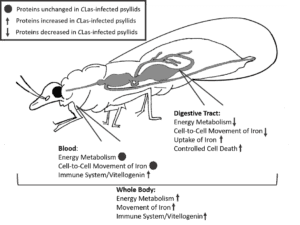News
Blood, sweat and tears: All in a day’s work fighting citrus greening disease

Researchers collected psyllid blood using tiny glass capillaries (needles) inserted near the legs. A bar 1mm in length is provided for scale.
Image credit: Kruse and Ramsey et al., 2018
Around this time last year, PhD student Angela Kruse and postdoctoral scientist Dr. John Ramsey were huddled over microscopes, using tiny needles to painstakingly extract blood, also known as hemolymph, from 300 Asian citrus psyllids – insects about the size of a sesame seed. Despite their innocuous appearance, these psyllids can carry the bacteria that causes citrus greening disease, an epidemic that’s devastating the American citrus industry and citrus production world-wide. However, new insight from Kruse and Ramsey’s efforts may bring us one step closer to a solution.
Citrus greening is a fatal, incurable disease of orange, lemon, and other citrus species, caused by the bacterium Candidatus Liberibacter asiaticus (CLas). Currently, every citrus tree in Florida is believed to be infected, as well as a growing number of trees in California, Texas, and other citrus-growing states. In a paper published this month in the Journal of Proteome Research, Kruse and Ramsey investigate the effect of CLas on psyllid blood proteins.
Why would insect blood be important in studying a plant disease? In some ways, CLas can be considered a pathogen of psyllids, as well as a pathogen of plants. In the lab, psyllids infected with CLas grow faster and produce more offspring, but also live shorter lives and show signs of digestive tract damage. As in humans and other animals, blood is a central part of the insect immune system, and may hold important clues about psyllids’ response to CLas.
“We hypothesized that the hemolymph may play a role in the insect’s response to CLas,” says Kruse, regarding their decision to study psyllid blood. “We want to understand the insect’s immune system as deeply as possible so that we can identify new ways to reduce transmission of CLas by these insects.”

A comparison of the effects of CLas on proteins in various psyllid tissues. The insect digestive tract is shown in gray, while the blood fills the body cavity. Controlled cell death (also called programmed cell death) occurs when cells deliberately die, often in response to infection or damage.
Image credit: Adapted from Kruse and Ramsey et al., 2018
Previous work by Kruse and colleagues in Dr. Michelle Heck’s lab at the USDA ARS and the Boyce Thompson Institute found significant changes in the digestive tracts of psyllids infected with CLas. Given these data and the importance of blood in immunity, they were surprised to find that CLas infection had only minor effects on blood proteins: Levels of less than 1% of blood proteins were different between infected and uninfected psyllids, whereas infection impacted about 15% of digestive tract proteins.
However, Kruse notes that CLas effects on blood proteins were “not random” and were “specifically related to the insect’s immune system and fat metabolism”. Higher levels of the latter proteins may indicate a greater emphasis on energy production in infected psyllids, consistent with previous observations from Nabil Killiny’s lab at the University of Florida that CLas-infected insects seem more hungry than uninfected insects.
Also among the proteins affected by CLas were several vitellogenins. Vitellogenins are best known as precursors to major components of insect egg yolks; however, several studies support a role for some vitellogenins in immunity. At least two of the vitellogenins affected by CLas are expressed only in female insects, suggesting that a psyllid’s sex may impact its response to infection. This is an important finding for future work in this area, as researchers do not always consider male and female insects separately.
“This work extends our understanding of the immune response of the Asian citrus psyllid to the citrus greening bacterium, which has the potential to enable the development of targeted pest and pathogen control strategies,” says Ramsey. Kruse, Ramsey, Heck lab members and their many collaborators plan to continue studying CLas movement in psyllids, in the hope of finding treatments that growers can use to prevent transmission.
This research was funded by the USDA-ARS, USDA specialty crops grant numbers 2015-70016-23038 and 2016-70016-24779, and California Citrus Research Board Grant number 5300-163.

